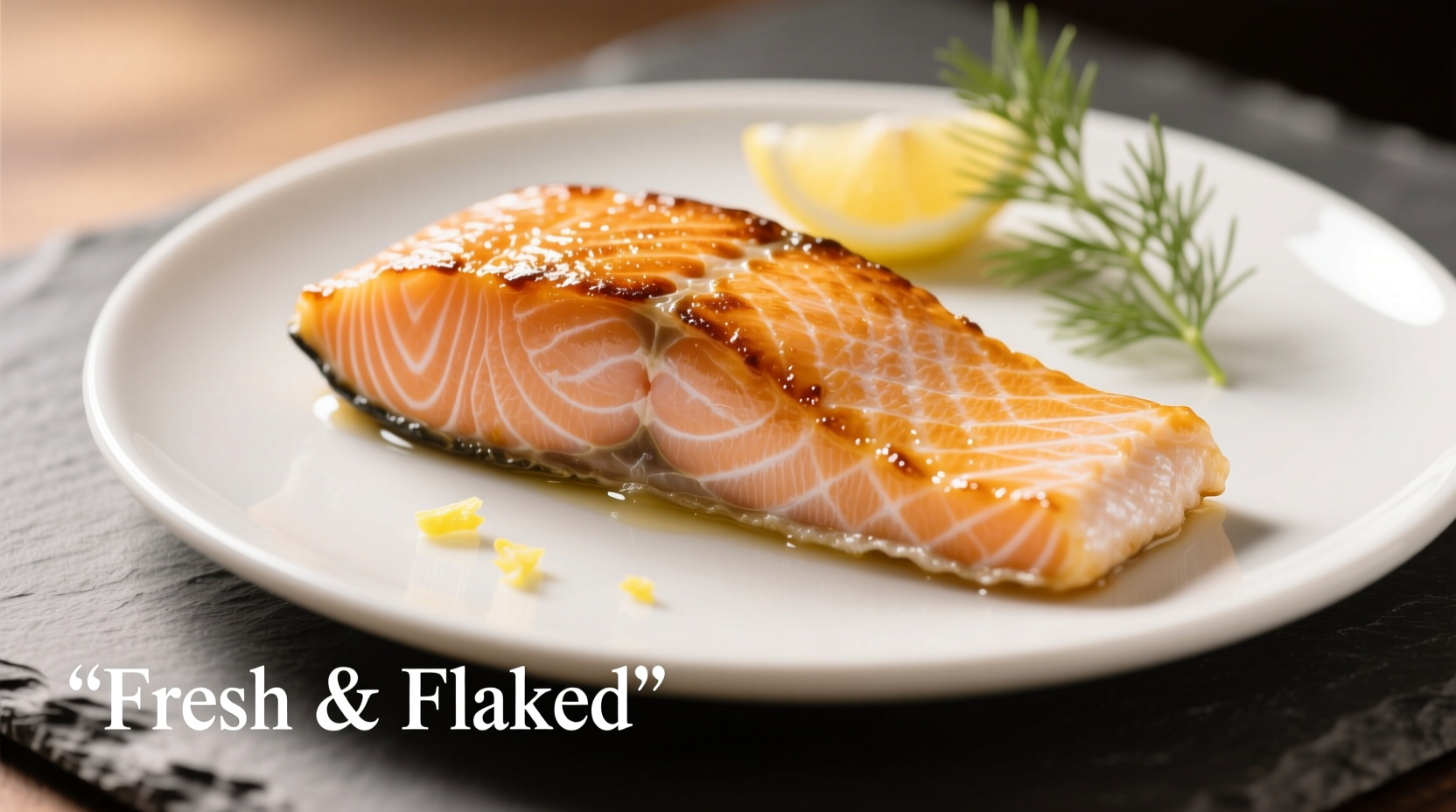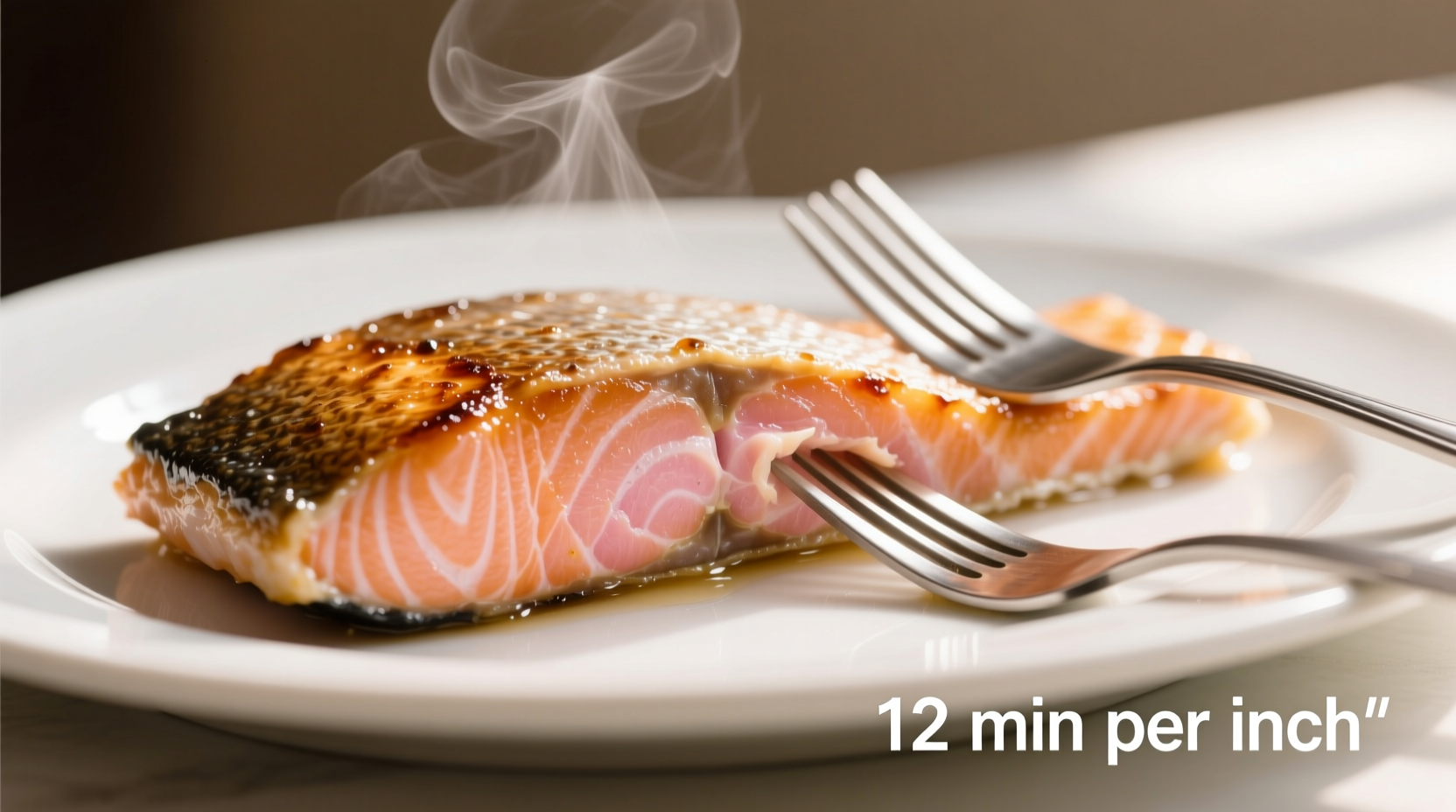Getting salmon cooking time right separates a flaky, moist masterpiece from a dry, overcooked disappointment. As a professional chef who's taught thousands of home cooks, I've seen the same mistakes repeated: guessing cooking times, skipping the thermometer, and ignoring thickness variables. Let's fix that with science-backed timing you can trust.
Why Standard Cooking Times Fail (And What Actually Works)
Most online "perfect salmon" guides give one-size-fits-all timing that ignores critical variables. The truth? Your salmon's thickness, starting temperature, and cooking method dramatically impact timing. Here's what matters most:
- Thickness is king: A 2-inch fillet needs nearly twice as long as a 1-inch cut
- Cold vs. room temperature: Chilled salmon adds 2-3 minutes to cooking time
- Carryover cooking: Salmon continues cooking 5-10°F after removal from heat
- Pan material matters: Cast iron retains heat better than stainless steel
| Cooking Method | 1-inch Fillet Time | 1.5-inch Fillet Time | Perfect Temp Range |
|---|---|---|---|
| Pan-searing (skin-on) | 6-8 min total | 10-12 min total | 125-130°F off-heat |
| Baking (400°F) | 10-12 min | 15-18 min | 120-125°F off-heat |
| Grilling (medium-high) | 8-10 min | 12-15 min | 125-130°F off-heat |
| Poaching (160°F liquid) | 10-12 min | 15-18 min | 120-125°F off-heat |
The Doneness Timeline: What Happens Inside Your Salmon
Understanding the protein transformation during cooking prevents guesswork. As salmon heats:
- 100-110°F: Proteins begin denaturing, flesh turns translucent pink
- 115-120°F: Albumin (white protein) starts appearing, flesh firms slightly
- 125-130°F: Perfect medium-rare - flesh separates easily but remains glossy
- 140°F+: Overcooked - proteins squeeze out moisture, becoming dry and chalky
According to FDA food safety guidelines, fish should reach 145°F for absolute safety. However, professional chefs pull salmon at 125-130°F because carryover cooking during resting achieves safe temperatures while preserving moisture. For vulnerable populations (pregnant women, elderly, immunocompromised), follow the FDA's 145°F recommendation.

Three Foolproof Doneness Tests (No Thermometer Needed)
While a thermometer is ideal, these visual and tactile methods work when you're unprepared:
The Flake Test
Gently press the thickest part with a fork. Properly cooked salmon will separate into clean flakes with slight resistance. If it falls apart immediately, it's overdone; if it doesn't flake, it needs more time.
The Color Clue
Watch the color change from deep red to opaque pink. When the color change reaches halfway through the thickest section, it's ready to rest. The center should still look slightly translucent but not raw.
The Finger Test
Press the salmon firmly. Perfectly cooked fish offers medium resistance (like the base of your thumb when making an OK sign). Undercooked feels soft like your palm; overcooked feels firm like your forehead.
Avoid These 3 Costly Timing Mistakes
Even experienced cooks fall for these timing traps:
- Mistake #1: Setting a timer without checking thickness
Salmon thickness varies wildly. Always measure the thickest part with a ruler before cooking. For every 0.5-inch beyond 1 inch, add 2-3 minutes to cooking time.
- Mistake #2: Ignoring resting time
Skip the 5-minute rest and you'll lose precious juices. Resting allows heat to distribute evenly and proteins to relax. Cover loosely with foil to prevent overcooking.
- Mistake #3: Cooking straight from the fridge
Cold salmon (below 40°F) needs 2-3 extra minutes and often cooks unevenly. Pat dry and let sit at room temperature for 15-20 minutes before cooking for even results.
Special Cases: When Standard Times Don't Apply
Certain situations require timing adjustments:
- Skin-on fillets: Start skin-side down for 75% of cooking time to render fat and crisp skin
- Cedar-plank grilling: Add 2-3 minutes as wood insulates the fish
- Marinated salmon: Sugar-based marinades brown faster - reduce heat by 25°F
- Frozen salmon: Add 50% more time and never cook from frozen without thawing first
For food safety verification, the USDA Food Safety and Inspection Service confirms that fish cooked to 145°F is safe, but emphasizes that carryover cooking continues the process after removal from heat. This explains why professional kitchens pull salmon at lower temperatures.
Perfect Timing for Your Cooking Method
Pan-Seared Salmon: The Crisp-Skin Method
For restaurant-quality results:
- Pat fillets completely dry and season
- Heat oil in cast iron until shimmering (medium-high)
- Skin-side down for 75% of cooking time (4-6 minutes for 1-inch)
- Flip and cook 25% of time (1-2 minutes)
- Finish with butter basting for flavor infusion
Oven-Baked Salmon: Hands-Off Perfection
Ideal for meal prep or multiple portions:
- Preheat to 400°F with rack in center position
- Place salmon on parchment-lined sheet pan
- Cook 10-12 minutes for 1-inch fillets
- Check at 8 minutes - thicker pieces need more time
- Broil 30-60 seconds for golden finish if needed
Your Salmon Timing Cheat Sheet
Bookmark these quick-reference points:
- Always measure thickness before cooking
- 125°F off-heat = perfect medium doneness after resting
- 1 inch = 10-12 minutes total cooking time across methods
- Rest for 5 minutes minimum before serving
- When in doubt, undercook slightly - you can always cook more
Frequently Asked Questions
Here are answers to the most common salmon timing questions:
How long to cook salmon at 375°F?
At 375°F, bake salmon for 12-15 minutes for 1-inch fillets. Lower temperatures require longer cooking but reduce the risk of overcooking. Check at 10 minutes using a thermometer - target 120-125°F off-heat for medium doneness after resting.
Can salmon be slightly pink in the middle?
Yes, properly cooked salmon should be slightly translucent pink in the center when removed from heat. This indicates medium doneness (125-130°F). The pink color will lighten during the 5-minute rest period as proteins continue to denature. Fully opaque salmon is overcooked and will be dry.
How do I prevent white foam (albumin) on cooked salmon?
To minimize albumin (the white protein foam): 1) Soak salmon in a brine (1 tbsp salt per cup water) for 10 minutes before cooking, 2) Cook at lower temperatures (325-350°F), 3) Never cook straight from the refrigerator. The albumin is harmless but indicates proteins are being squeezed out too quickly due to high heat or cold-start cooking.
How long to cook frozen salmon?
Never cook frozen salmon without thawing first. Thaw overnight in the refrigerator, then cook as usual. If pressed for time, place sealed salmon in cold water for 30-60 minutes until thawed. Cooking frozen salmon results in uneven cooking - the outside overcooks while the center remains raw. The FDA recommends against cooking fish directly from frozen due to food safety risks.
Why is my salmon dry even with proper timing?
Dry salmon usually results from one of three issues: 1) Not resting after cooking (juices escape immediately), 2) Over-seasoning with salt before cooking (draws out moisture), or 3) Using low-fat wild salmon without adequate fat protection. For leaner wild salmon, cook to 120°F off-heat instead of 125°F, and always rest covered. Farm-raised salmon has more fat and can handle slightly higher temperatures.











 浙公网安备
33010002000092号
浙公网安备
33010002000092号 浙B2-20120091-4
浙B2-20120091-4